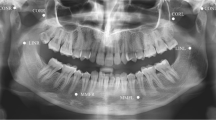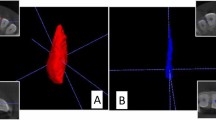Abstract
The current study aimed to select the best dental morphological identifiers for human identification. Sixty-two panoramic radiographs were collected retrospectively, in which six measurements were performed on all seven mandibular left permanent teeth: tooth length (TL), crown length (CL), root length (RL), crown width (CW), cervical width (CEJW), and root width (RW). Nine length–width ratios were then calculated using these measurements. Three groups of statistics were considered: (1) inter-observer reliability quantified by intra-class correlation (ICC); (2) mean “potential set”; and (3) Spearman correlation. A step-by-step cascade was then established based on selected parameters. In a univariate approach, the following parameters were the best identifiers: TL/CW for tooth 36 (ICC 0.82; mean potential set 13.7%), TL/CEJW for tooth 35 (ICC 0.87; mean potential set 15.2%), and TL/RW for tooth 32 (ICC 0.89; mean potential set 16.0%). The correlations between these three parameters ranged from 0.24 to 0.47. In a multivariate approach, the following parameters had the best identifying capacity: all parameters combined for tooth 31 (mean potential set 8.1%), for tooth 35 (mean potential set 11.9%), and for tooth 32 (mean potential set 16.3%). In conclusion, a single ratio in a specific tooth narrows down the potential set of matches, but the mean potential set remains relatively large. Combining all ratios of a single specific tooth increases the certainty of the match. In particular, tooth 31 was the strongest identifier.




Similar content being viewed by others
References
United States Army, Institute of Dental Research, Walter Reed Army Medical Center (1990) Computer assisted postmortem identification via dental and other characteristics. USAIDR Inf Bull 5:1
Brogdon BG (1998) Forensic radiology. CRC Press, Boca Raton, FL, USA
De Valck E (2006) Major incident response: collecting ante mortem data. Forensic Sci Int 155:S15-19. https://doi.org/10.1016/j.forsciint.2006.02.004
Jain N (2013) Ante-mortem dental records and forensic significance. Indian J Med Forensic Med Toxicol 7:42–44
Singh KA, Spencer AJ (2004) Relative effects of pre- and post-eruption water fluoride on caries experience by surface type of permanent first molars. Community Dent Oral Epidemiol 32:435–446. https://doi.org/10.1111/j.1600-0528.2004.00182.x
Adams BJ (2003) The diversity of adult dental patterns in the United States and the implications for personal identification. J Forensic Sci 48:497–503
Adams BJ (2003) Establishing personal identification based on specific patterns of missing, filled and unrestored teeth. J Forensic Sci 48:487–496
Fridell S, Ahlqvist J (2006) The use of dental radiographs for identification of children with unrestored dentitions. J Forensic Odonto-Stomatol 24:42–46
Marya CM (2011) A textbook of public health dentistry. Jaypee Brothers Medical Publishers (P) Ltd. New Delhi, India
Morgan B, Alminyah A, Cala A, O’Donnell C, Elliott D, Gorincour G, Hofman P, Iino M, Makino Y, Moskata A, Robinson C, Rutty GN, Sajantila A, Vallis J, Woodford N, Woźniak K, Viner M (2014) Use of post-mortem computed tomography in Disaster Victim Identification. Positional statement of the members of the disaster victim identification working group of the international society of forensic radiology and imaging. J Forensic Radiol Imaging 2:114–116
Gustafson G (1996) Forensic odontology. American Elsevier Publishing Co., New York, USA
Grieve M, Wiggins K (2001) Fibres under fire: suggestions for improving their use to provide forensic evidence. J Forensic Sci 46:835–843
Scholl SA, Moody GH (2001) Evaluation of dental radiographic identification: an experimental study. Forensic Sci Int 115:165–169. https://doi.org/10.1016/s0379-0738(00)00305-4
Santoro V, Lozito P, Mastrorocco N, De Donno A, Introna F (2009) Personal identification by morphometric analyses of intra-oral radiographs of unrestored teeth. J Forensic Sci 54:1081–1084. https://doi.org/10.1111/j.1556-4029.2009.01106.x
Forrest AS, Wu HY (2010) Endodontic imaging as an aid to forensic personal identification. Aust Endod J 36:87–94. https://doi.org/10.1111/j.1747-4477.2010.00242.x
Pretty IA, Addy LD (2002) Associated postmortem dental findings as an aid to personal identification. Sci Justice 42:65–74. https://doi.org/10.1016/S1355-0306(02)71801-7
Van Der Meer DT, Brumit PC, Schrader BA, Dove SB, Senn DR (2010) Root morphology and anatomical patterns in forensic dental identification: a comparison of computer aided identification with traditional forensic dental identification. J Forensic Sci 55:1499–1503. https://doi.org/10.1111/j.1556-4029.2010.01492.x
Angelakopoulos N, Franco A, Willems G, Fieuws S, Thevissen P (2017) Clinically detectable dental identifiers observed in intra-oral photographs and extra-oral radiographs, validated for human identification purposes. J Forensic Sci 62:900–906. https://doi.org/10.1111/1556-4029.13310
MacLean D, Kogon S, Stitt S (1994) Validation of dental radiographs for human ID. Int Dent J 39:1195–1200
Eliasziw M, Young SL, Woodbury MG, Fryday-Field K (1994) Statistical methodology for the concurrent assessment of interrater and intrarater reliability: using goniometric measurements as an example. Phys Ther 74:777–789
Milheiro A, De Tobel J, Capitaneanu C, Shaheen E, Fieuws S, Thevissen P (2021) Quantifying the potential of morphological parameters for dental identification: part 1—proof of concept. Int J Leg Med. (in press)
Kieser JA, Bernal V, Waaddell JN, Dip Tech M, Raju S (2007) The uniqueness of the human anterior dentition: a geometric morphometric analysis. J Forensic Sci 52:671–677. https://doi.org/10.1111/j.1556-4029.2007.00403.x
Capitaneanu C, Willems G, Jacobs R, Fieuws S, Thevissen P (2017) Sex estimation based on tooth measurements using panoramic radiographs. Int J Legal Med 131:813–821. https://doi.org/10.1007/s00414-016-1434-0
Smith BG, Robb ND (1996) The prevalence of tooth wear in 1007 dental patients. J Oral Rehabil 23:232–239. https://doi.org/10.1111/j.1365-2842.1996.tb00846.x
Lambrechts P, Braem M, Vuylsteke-Wauters M, Vanherle G (1989) Quantitative in vivo wear of human enamel. J Dent Res 68:1752–1754. https://doi.org/10.1177/00220345890680120601
Hugoson A, Bergendal T, Ekfeldt A, Helkimo M (1988) Prevalence and severity of incisal and occlusal tooth wear in an adult Swedish population. Acta Odontol Scand 46:255–256. https://doi.org/10.3109/00016358809004775
Ray DS, Wiemann AH, Patel PB, Ding X, Kryscio RJ, Miller CS (2015) Estimation of the rate of tooth wear in permanent incisors: a cross-sectional digital radiographic study. J Oral Rehabil 42:460–466. https://doi.org/10.1111/joor.12288
Enabulele JE, Ehizele AO (2019) Prevalence and pattern of restorations on permanent molar teeth among adult dental patients. Dent Oral Craniofacial Res 5:1–4. https://doi.org/10.15761/DOCR.1000290
Author information
Authors and Affiliations
Corresponding author
Ethics declarations
Ethics approval
Approval was obtained from the Ethics Committee of the University Hospitals Leuven, Leuven, Belgium (December 9, 2019). This work was presented at the Annual Meeting of the American Academy of Forensic Sciences on 18 February 2021, USA (Abstract G11).
Informed consent
Not applicable.
Conflict of interest
The authors declare no competing interests.
Additional information
Publisher's note
Springer Nature remains neutral with regard to jurisdictional claims in published maps and institutional affiliations.
Rights and permissions
About this article
Cite this article
Shu, Y.L., De Tobel, J., Jun, C. et al. Quantifying the potential of morphological parameters for human dental identification: part 2—selecting the strongest identifiers in mandibular permanent teeth. Int J Legal Med 136, 1821–1828 (2022). https://doi.org/10.1007/s00414-022-02851-9
Received:
Accepted:
Published:
Issue Date:
DOI: https://doi.org/10.1007/s00414-022-02851-9




